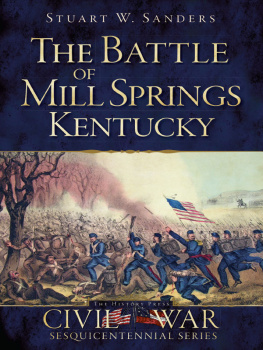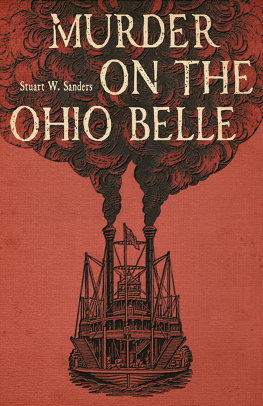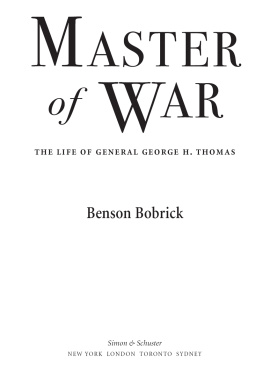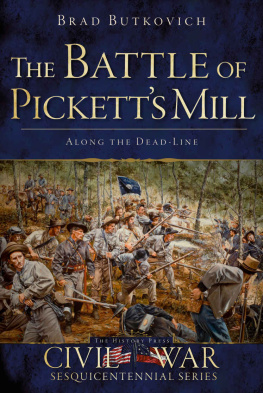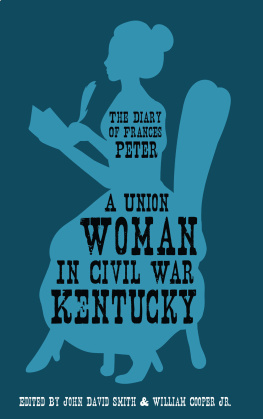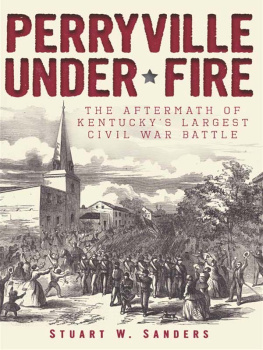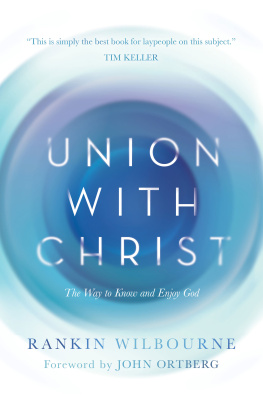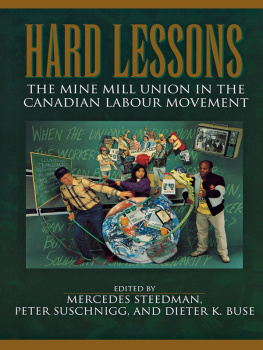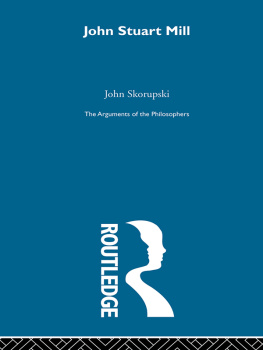

Published by The History Press
Charleston, SC 29403
www.historypress.net
Copyright 2013 by Stuart W. Sanders
All rights reserved
First published 2013
e-book edition 2013
Manufactured in the United States
ISBN 978.1.61423.965.9
Library of Congress CIP data applied for.
print edition ISBN 978.1.60949.829.0
Notice: The information in this book is true and complete to the best of our knowledge. It is offered without guarantee on the part of the author or The History Press. The author and The History Press disclaim all liability in connection with the use of this book.
All rights reserved. No part of this book may be reproduced or transmitted in any form whatsoever without prior written permission from the publisher except in the case of brief quotations embodied in critical articles and reviews.
Contents
Acknowledgements
This tale begins with a ghost story. Not an exciting one, Im afraid, or a terrifying one. It is, nonetheless, a ghost story, and one that got me interested in the Battle of Mill Springs.
Several years ago, I toured the Mill Springs battlefield as part of a heritage tourism event that I helped organize. When the tour began, I stood behind the group, near the spot where Confederate General Felix Zollicoffer had been killed. As the guide talked about the campaign, something gently squeezed the back of my arm. I turned around, expecting to see a friend who had helped organize the tour. No one was behind me. No one was near me. Surprised, I turned around twice in a circle, trying to see who it could have been. No one was there.
I have no explanation. For the sake of argument, let us simply say that it was a mild pull from the past. It was neither jarring nor frightening. Instead, it was a pay attention to me or an Im here moment. With this book, I hope that I have paid adequate attention.
While that surprising event got me interested in the subject, many people have helped along the way.
First, many thanks go to several research repositories and their staffs, including the Kentucky Historical Society, Roger Stapleton and the Kentucky Heritage Council, Jim Holmberg and the archivists at the Filson Historical Society, the Indiana Historical Society and Karyn Branham, former director of the Mill Springs Battlefield Association.
Mark D. Jaeger was extremely generous and provided me with several crucial sources about the 10th Indiana Infantry Regiment. Many of these sources were vital for this book, and I greatly appreciate his willingness to help.
A thank-you to those who supplied images, including the Library of Congress; Jennifer Duplaga and Charley Pallos at the Kentucky Historical Society; Jim Campi and Mary Koik at the Civil War Trust; Joseph E. Brent and Maria Brent with Mudpuppy and Waterdog, Inc.; and Bob Glass of Centre College.
Thanks to Bill Neikirk, former president of the Mill Springs Battlefield Association. I could not have written this book without his leading me on an extensive tour of the battlefield. Bills knowledge of the archaeological evidence and his comprehension of the terrain were vital in formulating my understanding of the battle. Bill also read the manuscript and made some very helpful suggestions.
I am grateful for supportive friends Erik Drake and Mignon Brousseau, Steve and Amy Isola, John and Andrea Mesplay and their families. Additional thanks go to Brian Grimmer, Gary Neighbors, Cindy Neighbors, Brian Neighbors, Heather Neighbors, Mark Read, Harv Smith, Robert H. Williams and W. L. Wilson. Much appreciation for my brother, Wallace Sanders, and my sister-in-law, Catherine Edwards Sanders.
Many thanks to my editor, Banks Smither, and the staff of The History Press. Working with The History Press on my first book, Perryville Under Fire: The Aftermath of Kentuckys Largest Battle, was a great experience, and this project has been equally fulfilling.
I also thank my colleague Tim Talbott, who kindly read the manuscript and made important suggestions.
I appreciate the encouragement of my friend, colleague and fellow carpooler Don Rightmyer. Don and his wife, Bonnie, both read the manuscript, and I appreciate their comments.
My parents were extremely supportive and were very helpful editors. My father, Dr. I. Taylor Sanders II, taught history at Washington and Lee University for forty-two years, while my mother, Barbara Sanders, is a former English teacher. I am appreciative of their editorial skills but more thankful to have them as parents.
The best part of writing this book is that it gave me the opportunity to tromp around the battlefield with my wife, Jenny, and our three wonderful children: John, Anne and Elizabeth. Although my youngest worried about nonexistent bears in the woods, she had her two older siblings to protect her. We saw no bears, but it was a day that I will always remember. Therefore, I dedicate this book to them, with much love.
Introduction
The three boys walked toward the battlefield, their picks and shovels slung over slender shoulders. One of them, barely ten years old, was pulled to the recent scene of fighting by his older brothers. As the trio neared the battleground, they passed the abandoned accoutrements of war; muskets, bayonets, coats and cartridge boxes lay scattered, thrown away by fleeing soldiers. The boys probably knew little about the fight that had happened near their homes. As they watched wagons full of wounded soldiers rumble away, however, they might have spoken of the Rebel general Zollicoffer, who was shot down before his solders fled to the swollen Cumberland River.
Youthful chatter ended when they reached the field. After the battle nobody knew what to do, one later wrote.
The bodies were all covered up with ice and everyone was running around crying. Father hitched the mules up to a dirt scoop and dug three long trenches to place the bodies in. The bodies were frozen to the ground and we had to take shovels and pry them from the groundWe stacked the bodies in the wagon like firewood, legs, hands, and arms were in odd postures and some bodies did not have all of their parts. The bodies were placed in the trenches and covered.
While these soldiers were the immediate casualties from the Battle of Mill Springs, Kentucky, others contended with longer-lasting consequences. When the fighting raged, Confederate officer Bailie Peyton shot Union lieutenant Tenbroeck Strout near the spine. An operation was deemed too dangerous, so the bullet remained in Strouts back. In 1880, more than eighteen years after the battle, Strout reportedly died of lead poisoning, making him a final casualty of the Battle of Mill Springs. Peyton, who was shot in the face and killed immediately after he wounded Strout, lived on in his familys memory. His fathers sword, which Peyton wore during the fight, eventually carried one mans hope for sectional reconciliation. In 1907, M.C. Tuttle, whose family had kept the sword since the battle, wrote to Bailies brother. Since the war was long over, Tuttle wanted to return the sword to the family. I sincerely trust that it may never be unsheathed again unless in defense of all the stars and stripes, Tuttle wrote.
The three boys who helped their father inter the Rebel dead were never psychologically reconciled. In later years, the brothers reputedly suffered mental trauma, and onewho killed one of the otherssupposedly died in an insane asylum. These were the forgotten casualties of Mill Springs. As Confederate veteran Bennett Young penned, the fight was one full of pathos and tragedy.
Next page
